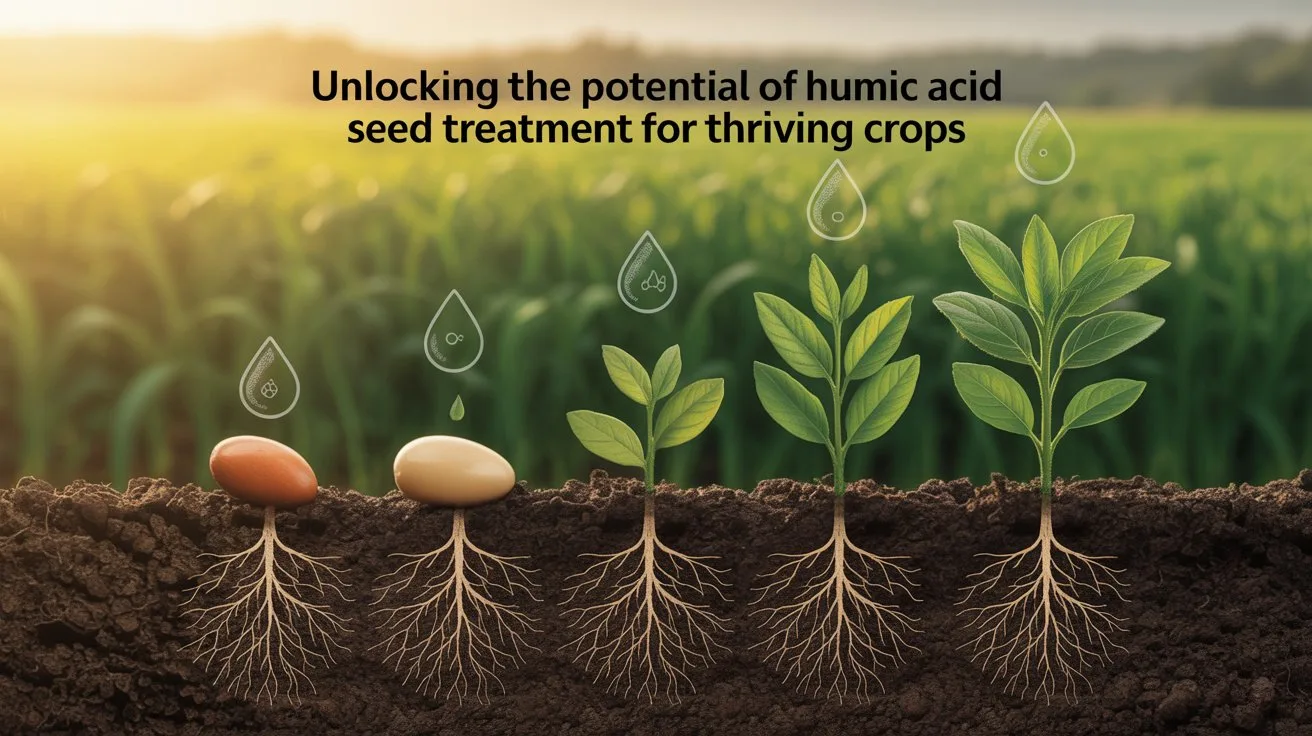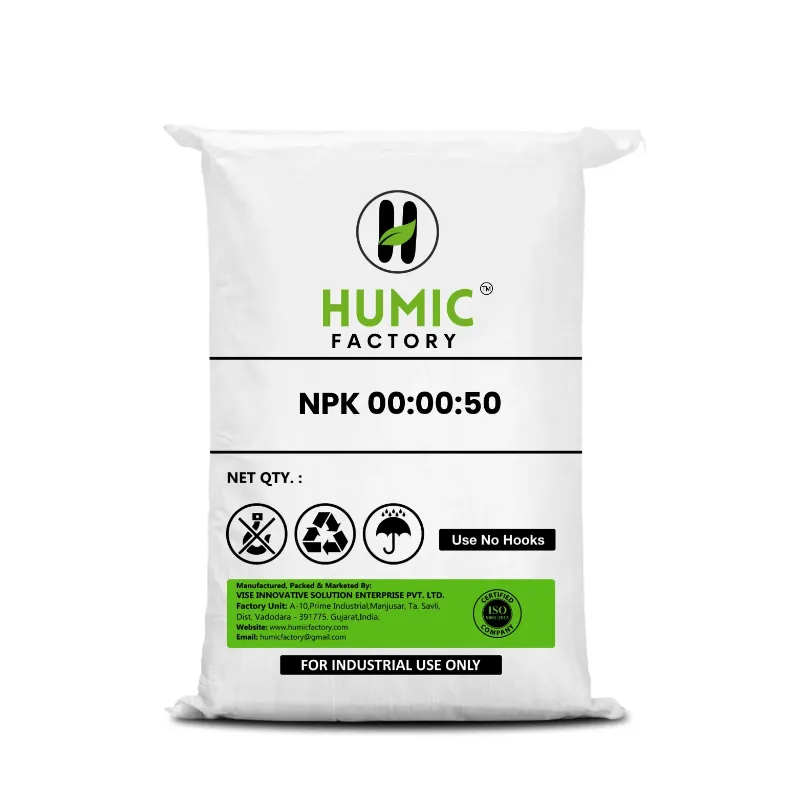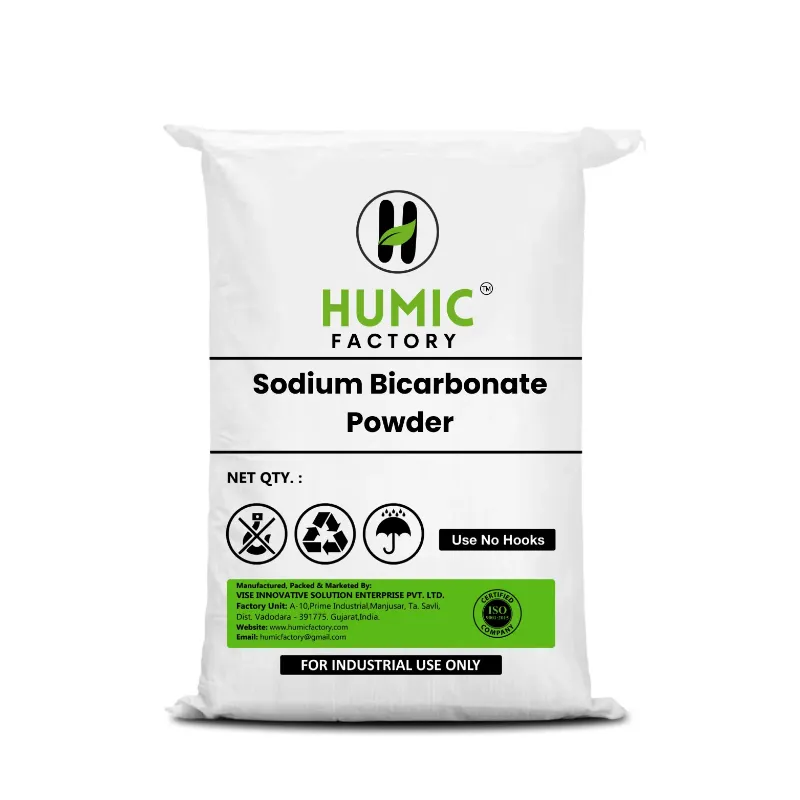Humic acid seed treatment is becoming increasingly important in modern agriculture. Humic acid, as a natural decomposition product of plant material, can significantly boost seed health and fosters a healthier crop development from the ground up.
Farmers see the benefit of humic acid seed treatments as they improve seed germination, increase the strength of early root development, and improve its nutrient uptake with the advantage of being able to reduce the plant's susceptibility to environmental stresses, not to mention having plants that emerge more uniformly and have a much stronger developmental curve.
Organic growers, by applying humic acid fertilizer as a seed coating immediately before planting, are ensuring their crops benefit from them as fertilizers as soon as they are planted. For example, using similar results as they would in cereals, vegetables or pulses. They have proven over time that enhancing crop yield and soil health is possible across the board.
Introduction: Understanding Humic Acid and Its Role in Agriculture
Humic acid has become a valuable resource for farmers in the fight for sustainable agriculture. Humic acid, which is derived from the decomposition of organic matter, is an important component of soil humus. It plays an essential role in improving soil structure, holding nutrient uptake, and ensuring the microbial activity that helps sustain soil health. Humic acid has proven to be effective in seed treatment, applied at the seed stage, allowing plants to benefit from all the improvements at germination and more healthy root establishment.
What Is Humic Acid and Why It Matters in Modern Farming
Humic acid is an organic compound found naturally in soil and composted plant materials. Humic acid becomes a humic acid fertilizer when it is used to improve the physical, chemical and biological properties of the productivity of soil. In today's farming methods, these areas are often depleted and usually need supplementation with humic acid.
Humic acid has many easy to recognize characteristics, including:
- Enhances energy (nutrient) uptake
- Enhances retention of water in soil
- Stimulates beneficial microbials
- Detoxifies soils of harmful residues
These characteristics provide humic acid seed treatment as an effective treatment scheme to power early season plant growth and contribute to optimal productivity potential.
Benefits of Humic Acid for Soil and Plant Development
When applied at the seed stage, humic acid delivers a wide range of benefits, impacting both the soil and the emerging plant:The use of humic acid fertilizer ensures that these benefits are available right from the seed stage, laying the groundwork for a more resilient crop.
How Humic Acid Seed Treatment Enhances Farming Practices
The application of humic acid seed treatment is an easy yet powerful way to increase germination rates and general plant health. The humic acid basically coats the seed with a thin layer of humic substances and works to:
- Promote faster, more consistent germination.
- Increase the seed's ability to absorb moisture.
- Support healthier root development.
- Reduce overall synthetic requirement as it will increase natural soil fertility.
For farmers wanting to use more sustainable methods and be more productive, applying humic acid seed treatment is a perfect adjunct to modern practices. When humic acid is applied at the very beginning of the plants life cycle, there is greater potential for a healthier and more productive season.
Why Choose Humic Acid Seed Treatment Over Traditional Methods
The choice to switch from conventional chemical treatments to humic acid seed treatment is not only smarter for your crops — it's better for your land, your yield, and the environment. With the added effect of humic acid fertilizer, you're literally planting the seeds for success!
Humic Acid vs. Chemical Seed Treatments: Key Advantages
Traditional seed treatments often rely heavily on synthetic chemicals, which may offer short-term protection or growth stimulation but can negatively impact soil health and microbial life over time. In contrast, humic acid seed treatment works with nature—enhancing the seed’s natural capabilities while also improving the surrounding soil ecosystem.
Key Advantages of Humic Acid Over Chemicals:By choosing humic acid fertilizer in seed treatments, farmers not only protect the seed but also lay the foundation for a thriving plant and healthy soil.
Eco-Friendly Farming with Humic Acid Fertilizer Solutions
As consumer demand shifts toward cleaner, more sustainable food sources, farmers are increasingly turning to humic acid as an eco-friendly alternative. When used in seed treatment, humic acid acts as both a growth enhancer and a soil rejuvenator.
Eco-friendly benefits include:
- Reduced reliance on chemical inputs
- Improved soil organic matter
- Promotion of natural nitrogen-fixing microbes
- Reduced carbon footprint in farming operations
This makes humic acid fertilizer a preferred choice in regenerative and organic agricultural systems, helping ensure that environmental integrity is maintained while productivity improves.
Sustainable Agriculture Starts at the Seed
Sustainability in agriculture isn't just about how you manage crops once they grow—it starts at the seed level. Using humic acid seed treatment is one of the most effective ways to align farming practices with long-term ecological goals.
Here's why:
- It supports natural germination processes without synthetic enhancers
- It boosts seedling vigor, reducing the need for additional chemical boosters
- It enables long-term improvement of soil structure and fertility
Humic acid treatments introduce a holistic, soil-to-plant solution that works in harmony with nature. Farmers who start with humic acid at the seed stage are investing in healthier crops, more resilient systems, and future-proof farming.
The Science Behind Humic Acid: How It Boosts Germination and Plant Vitality
Humic acid is an organic compound found in soil, compost, and other natural sources of decomposed organic matter. When used as a humic acid seed treatment, it acts as a powerful biostimulant that enhances seed performance and early-stage plant development. Its molecular structure allows it to interact directly with both seeds and soil, improving nutrient availability, water retention, and biological activity.
Role of Humic Substances in Germination Speed and Success
Humic substances, particularly humic acid, play a crucial role in accelerating seed germination. When used as a humic acid seed treatment, these organic compounds stimulate enzymatic activity within the seed, energizing early growth. This leads to:
- Faster radicle (root) emergence
- Improved seed-to-seedling transition
- Increased germination rates, even under stress conditions
Humic acid achieves this by enhancing the permeability of seed membranes, allowing better water absorption and metabolic activation—key elements that determine how quickly and successfully a seed sprouts.
Enhancing Root Growth with Humic Acid Fertilizer
Root development is foundational to plant strength and resilience. Humic acid fertilizer, especially when applied at the seed stage, promotes stronger and deeper root systems by:
- Stimulating cell elongation in the root zone
- Encouraging lateral root branching
- Enhancing root hair formation for better soil contact
With a robust root system established early on, plants are better equipped to access water and nutrients, especially during critical growth periods or in suboptimal soil conditions. This early boost leads to more vigorous plant vitality throughout the crop cycle.
Nutrient Uptake and Soil Activation Explained
Beyond direct seed benefits, humic acid acts as a powerful soil activator. It binds to micronutrients and macro-elements in the soil, creating chelates—organic molecules that make nutrients more bioavailable to young roots.
Here’s how humic acid fertilizer improves the nutrient environment:
Step-by-Step Guide to Applying Humic Acid Seed Treatment Effectively
While humic acid seed treatment is praised for its benefits to germination and seedling vigor, achieving optimal results depends heavily on proper application. Knowing the correct dosage, timing, and method ensures that seeds fully absorb the nutrients and biostimulant properties of humic acid fertilizer. In this guide, we outline best practices and common mistakes to help you maximize efficiency and growth.
How to Prepare and Apply Humic Acid Fertilizer to Seeds
Applying humic acid to seeds requires precision and care. Here's how to do it step-by-step:
Step 1: Choose the Right Form
- Select either liquid humic acid fertilizer for easy mixing or powdered humate for flexibility in solution strength.
Step 2: Mix the Solution
Dilute humic acid in clean, non-chlorinated water. A common ratio for seed treatment is:
- Liquid Form: 5–10 ml of humic acid per 1 liter of water
- Powder Form: 1–2 grams per liter of water
Step 3: Soak or Coat the Seeds
- Soak small seeds (vegetables, grains) for 6–12 hours in the diluted solution.
- For larger seeds (like pulses or maize), apply the solution as a light coat using a spray bottle and stir gently to ensure even coverage.
Step 4: Dry and Plant
- After soaking or coating, air-dry the seeds in a shaded area for 30–60 minutes before sowing.
Proper Dosage, Timing, and Application Best Practices
Getting the dosage and timing right is key to ensuring seeds benefit from the humic acid without stress.
Mistakes to Avoid When Using Humic Acid on Seeds
Even though humic acid seed treatment is beginner-friendly, a few missteps can limit its effectiveness:
- Overconcentration: Too much humic acid can create salt buildup or cause seed coat damage.
- Using tap water with chlorine: This can neutralize the organic compounds in humic acid fertilizer.
- Skipping the drying step: Planting wet seeds may lead to clumping or rot.
- Inconsistent coating: Uneven application means some seeds may not benefit fully.
By avoiding these mistakes, you ensure that the full power of humic acid is delivered to every seed.
Choosing the Best Humic Acid Fertilizer for Seed Treatment
The effectiveness of humic acid seed treatment depends not only on how it's applied—but also on the quality of the humic acid fertilizer used. With many products on the market, selecting the right one can make the difference between average and exceptional results. This guide helps you identify top-tier humic products that align with sustainable farming and seed health goals.
What to Look for in Quality Humic Acid Products
When evaluating a humic acid fertilizer for seed treatment, focus on the following key attributes:
- Source Material: Opt for fertilizers derived from leonardite, a naturally oxidized form of lignite, rich in humic substances.
- Humic Content: A good product will list 12–20% or higher humic acid concentration for effective seed treatment.
- Solubility: Ensure the product fully dissolves in water, especially for foliar and seed soak methods.
- pH Compatibility: Choose products with a neutral to slightly acidic pH to prevent seed coat damage.
- Heavy Metal Free: Check for lab certifications indicating the absence of harmful contaminants.
These features ensure that the humic acid seed treatment nourishes your seeds without side effects.
Liquid vs. Powder Forms: Which Works Better for Seeds?
Both liquid humic acid and powdered humate have their place in agriculture, but each has specific advantages for seed treatment:Liquid humic acid is often the preferred choice for its convenience and fast absorption, especially for farmers new to humic acid seed treatment practices.
Organic Certifications and Compatibility with Other Inputs
When using humic acid fertilizer as part of an organic or integrated farming system, certification and input compatibility are crucial.
- Organic Certification: Choose products certified by bodies like OMRI or ECOCERT to ensure compliance with organic farming standards.
- Input Compatibility: Ensure the humic acid is compatible with other seed coatings, biofertilizers, and inoculants.
- Non-Toxic & Biodegradable: Always check that your product is environmentally friendly and free of synthetic additives.
Using certified humic acid products not only benefits your seeds but also builds consumer trust and promotes sustainable agriculture.
FAQs
Q1. What is humic acid seed treatment and how does it work?
Humic acid seed treatment involves applying humic acid or humic acid fertilizer to seeds to enhance germination, nutrient uptake, and root development. It helps in improving soil structure and stimulating microbial activity, resulting in healthier, more resilient plants.
Q2. Can humic acid be used with other fertilizers or seed coatings?
Yes, humic acid can be safely combined with other fertilizers and seed coatings. It enhances the effectiveness of chemical or organic fertilizers by improving nutrient uptake and stimulating microbial activity in the soil.
Q3. How often should I treat seeds with humic acid?
Typically, humic acid seed treatment is applied once before planting. However, some applications may benefit from reapplication during the growing season, depending on the crop type and soil conditions.
Q4. Is humic acid seed treatment suitable for all crops?
Yes, humic acid seed treatment can be used for a wide range of crops, including vegetables, fruits, grains, and legumes. It's particularly beneficial for crops in poor soil or those that need a boost in germination and root development.
Q5. What’s the right dosage for humic acid in seed treatment?
The humic acid dosage for seed treatment typically ranges from 1-2 teaspoons per gallon of water. For humic acid fertilizer, follow the product’s specific instructions for optimal results based on the type of crop and soil condition.
Q6. How soon after treating should I plant the seeds?
You can plant the seeds immediately after treating them with humic acid. It’s best to allow the seeds to dry slightly before planting, but they do not need a long waiting period.
Q7. Does humic acid seed treatment qualify for organic farming?
Yes, humic acid seed treatment qualifies for organic farming as long as the product is certified organic. It is a natural soil enhancer and can be used in organic farming practices to promote healthier crops and improve soil quality.
Conclusion: Embrace the Power of Humic Acid Seed Treatment for a Healthier, Higher-Yielding Future
Incorporating humic acid seed treatment into your farming or gardening routine is a game-changer for improving soil health, accelerating seed germination, and boosting overall plant vitality. By enriching the soil with humic acid or humic acid fertilizer, you unlock the full potential of your seeds, ensuring stronger roots, enhanced nutrient absorption, and better resistance to environmental stresses.
This natural and sustainable approach not only promotes healthier, more productive plants but also reduces the dependency on synthetic fertilizers, making it an excellent choice for eco-friendly farming. As you embark on this transformative journey, choosing the right humic acid seed treatment will lead to healthier crops, improved yields, and long-term soil fertility.





